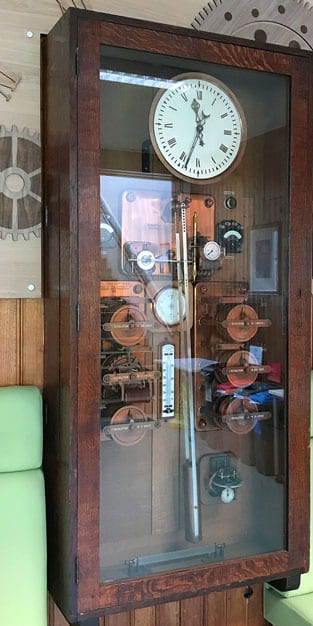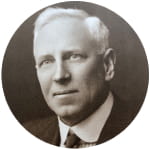Robertson’s ‘Time Machine’ gets a new lease of life
Last night saw the official unveiling of the newly restored Robertson Clock, a notable timepiece that previously graced the Wills Memorial Building and controlled the chiming of Great George, the huge bell at the top of the tower, from its inauguration in 1925 to the 1960s.
The ceremony took place in the Pugsley Lecture Theatre Foyer in the Faculty of Engineering’s Queen’s Building where the newly functioning clock takes pride of place (though it no longer controls Great George).
The clock was the brainchild of David Robertson (1875-1941), first Professor of Electrical Engineering at Bristol University. Among his many interests was the application of science to the design of accurate mechanical clocks and he authored many important papers on horology.
Making a case

Recognising its significance, the University’s ‘Historic Buildings and Gardens Committee’ chaired by Alan Stealey, Head of External Estates, made a commitment to return the clock to its former glory. Led by Dr John Haine, visiting Professor at the Faculty of Engineering, the restoration was entrusted to Johan ten Hoeve of The Clockworks.
As part of this initiative, Professor Robertson’s original engineering drawings will be made available online for the next generation of horologists. The clock was made by Messrs. Brecknell, Munro and Rogers of Thrissell Street, Bristol, “mechanical, electrical, and tramway engineers”.
A place in time
 Professor Robertson’s IET obituary pays tribute to his strength of character: “The fact that he was confined to an invalid’s chair by paralysis of the legs for the last 30 years of his life makes the achievement of his work so much the greater. With characteristic thoroughness and ingenuity, he so adapted his methods of teaching and working that he was able to fulfil all his duties… The beauty of his character was revealed by the way he bore this affliction, and his patience and kindliness were a constant source of inspiration to all who had the privilege of knowing him.” His students included Paul Dirac who later won the Nobel Prize for physics, and paid tribute in his writings to Robertson’s influence on his mathematical thinking.
Professor Robertson’s IET obituary pays tribute to his strength of character: “The fact that he was confined to an invalid’s chair by paralysis of the legs for the last 30 years of his life makes the achievement of his work so much the greater. With characteristic thoroughness and ingenuity, he so adapted his methods of teaching and working that he was able to fulfil all his duties… The beauty of his character was revealed by the way he bore this affliction, and his patience and kindliness were a constant source of inspiration to all who had the privilege of knowing him.” His students included Paul Dirac who later won the Nobel Prize for physics, and paid tribute in his writings to Robertson’s influence on his mathematical thinking.
Robertson’s name for the clock ‘A Time Machine for the University of Bristol’ – certainly hints at a wry sense of humour and maybe a nod to H G Wells. We think he’d be pleased to know that his clock will be keeping time far into the future, a talking point for students and the wider engineering community.
Ticking on
Although pendulum clocks have been superseded for keeping the world’s time, they are still human-scale mechanical oscillators. Pendulum dynamics is a fascinating field of research, still not fully understood even after 500 years of study. Aspects of the clock’s design offer a number of possibilities for student final year projects.
Further information
More about Professor Robertson, his clock and the history of the phase-locked loop can be found on Wikipedia:-
- https://en.wikipedia.org/wiki/David_Robertson_(engineer)
- https://en.wikipedia.org/wiki/Phase-locked_loop#History
More about the interdisciplinary undergraduate course to study Electrical and Mechanical engineering:-


